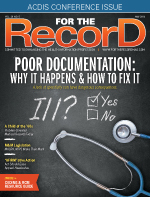Best Describe the Major Components of the Problem-oriented Medical Record
Core components Core components for the POMR. POR POMRproblĕm-ōrē-en-tĕd medi-kăl rekŏrd A medical record model designed to organize patient information by the presenting problem.

What Are The 10 Components Of Medical Records In A Hospital
A Problem Oriented Medical Record POMR is a way of recording patient health information in a way thats easy for physicians to read and revise.

. The Weeds outline the following core four components for the POMR. Despite the many technological advances in health care over the past few decades the typical patient record of today is remarkably similar to the patient record. The first problem is inadequate hypothesis generation and inattention while the second problem is the misinterpretation of findings.
After describing format and use of the records the author discusses their various uses in medical educational settings. Patient health recordsNot only is the record used to document patient care but the record is also used for financial and legal information and research and quality improvement purposes. Medications and medical allergies.
Advantages and Disadvantages of Electronic Medical Records. Because all this information must be shared among many professionals who constitute the healthcare team Young 92 and. A defined database of information to store the relevant information that has been gathered.
Methods of organizing medical records based on a Problem-oriented medical record POMR and source-oriented medical record SOMR Problem-oriented medical record POMR The problem-oriented medical record collect data or information from all members View the full answer. A problem list with problems defined in terms of the patients needs. The patient record is the principal repository for information concerning a patients health care.
First developed by Lawrence Weed MD in the 1960s the POMR gathers information from all members of the patients care team in order to determine a diagnosis and create a treatment plan. Database problem list diagnostic and treatment plan progress notes When editing a transcription document and you flag a certain area. It affects in some way virtually everyone associated with providing receiving or reimbursing health care services.
The basic idea of POMR is to equip doctors with the ability to understand the patients medical history. A problem list a defined data base initial plans and progress notes. A problem list with problems defined in terms of the patients needs.
The problems the patient is facing. Database problem list diagnostic and treatment plan progress notes. In contrast to the traditional diary method of record keeping organized according to the source of information.
The problem oriented medical record POMR has proved to be very successful in providing a structure that helps doctors record their notes about patients and view those notes subsequently in a manner that quickly gives them a good understanding of that patients history. Initial assessment general health history findings of the physical examination results of diagnostic and laboratory test psychosocial information nursing assessment and patients response to the illness or problem. Is an overview of patient information.
This corrects the article The problem oriented medical record in volume 2 on page 774. Which of the following best describe the major components of the problem-oriented medical record. The problem-oriented medical record POMR is a comprehensive approach to recording and accessing patient medical data.
A defined database of information to store the relevant informationHistory Physical Exam and Laboratory Data that has been gathered. For PORs we will define problem as anything that interferes with the health well being and quality of life of an individual that may be medical surgical obstetric social or psychiatric the problem oriented medical record POR has four parts. The family history lists the health status of immediate family members as.
4711779 PubMed - indexed for MEDLINE. In a POMR or problem oriented medical record the record is kepttogether by problem number a number is assigned to each problem. Which of the following best describe the major components of the problem-oriented medical record.
POR an approach to patient care record keeping that focuses on the patients specific health problems requiring immediate attention and the structuring of a cooperative health care plan designed to cope with the identified problems. Data regarding the patients exams mental status history etc. This approach has been validated by the American Institute of Medicine.
Plans of action for each problem developed in light of the other problems. Guide to Problem Oriented Medical Records. The record includes the patient database problem list plan of care and progress notes in an accessible format.
The first objective of problem oriented medical diagnosis is teaching and learning. The problems of the problem-oriented medical record. The medical record can be dissected into five primary components including the medical history often known as the history and physicalor hp laboratory and 12diagnostic test results the problem list clinical notes and treatment notes.
There are four components of the problem-oriented medical record form. Full text Get a printable copy PDF file of the complete article 286K or click on a page image below to browse page by page. The medical record may contain a summary of the patients current and previous medications as well as any medical allergies.
The problem oriented medical record POMR is a structured record made up of four main parts. Since its introduction to the medical world in 1968 POMR has been an important resource for. Problems with Electronic Health Records and Why You Should Consider Adopting POMR.
Initial Plans of action for each problem developed in light of the other problems. Progress notes in these records are kept in SOAP format.

Documentation Of Nursing Care Ppt Download

Electronic Medical Records The Components Of A Medical Record

No comments for "Best Describe the Major Components of the Problem-oriented Medical Record"
Post a Comment